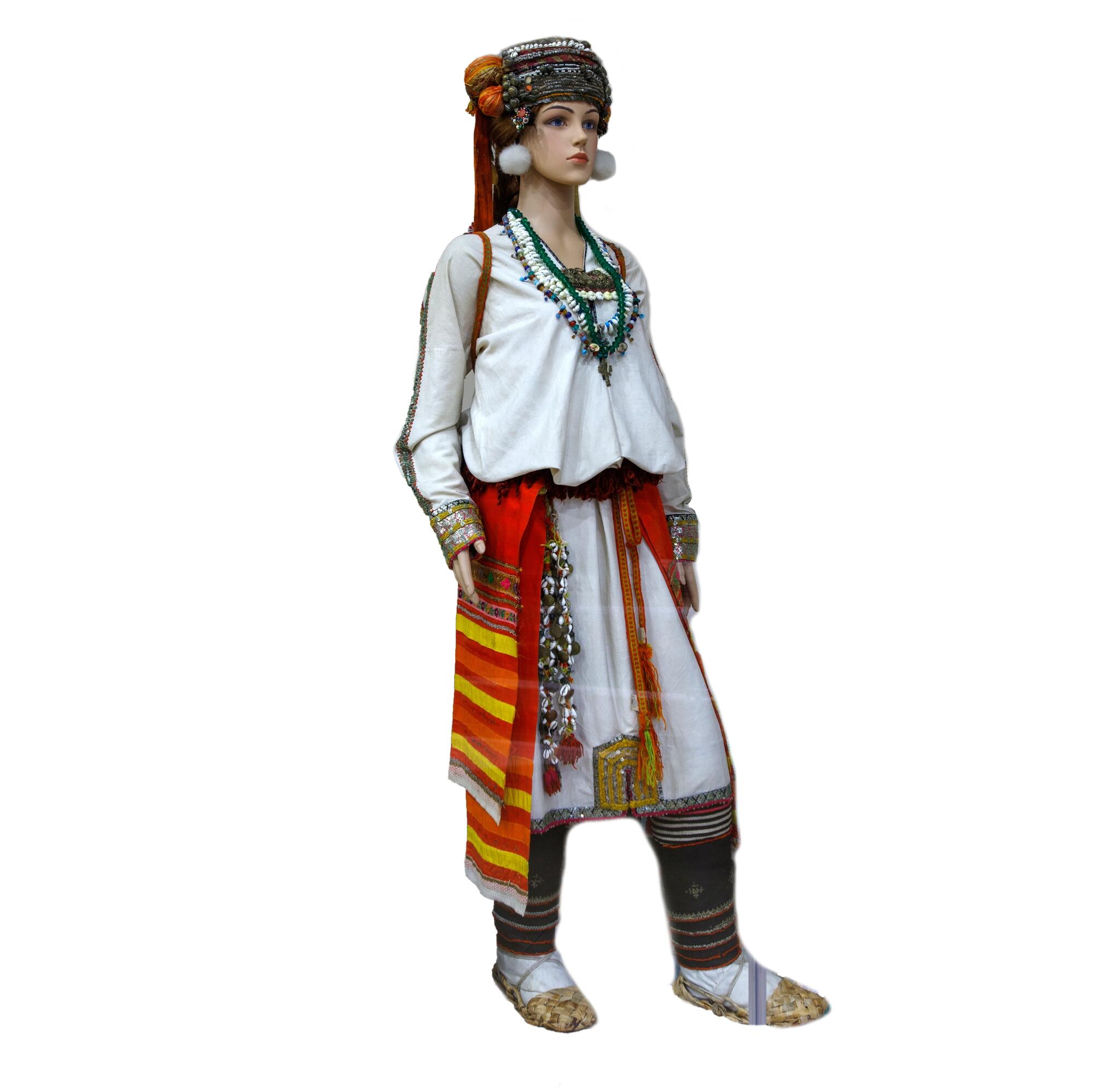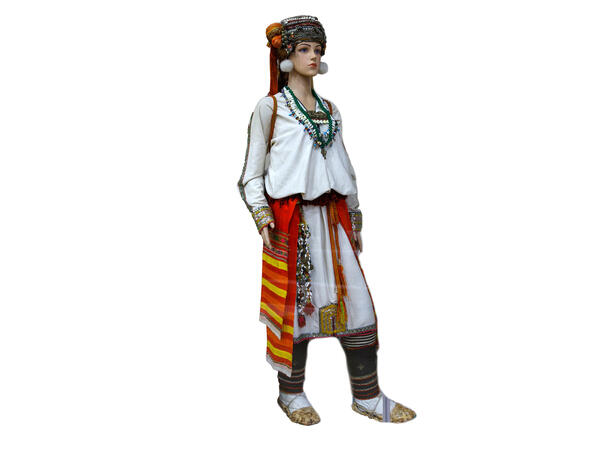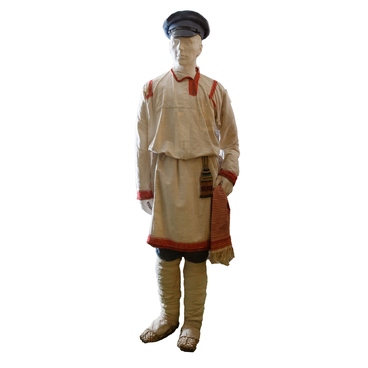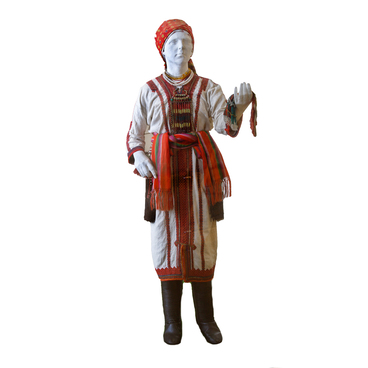The festive national Mordovian female costume was very complicated, multi-component, with an abundance of different decorations and with a whole complex of drapery techniques. A woman could not dress herself in such attire, so two or three people helped her to get ready for the holiday. The dressing ceremony lasted several hours.
The main qualities of a woman were health, strength and endurance and the costume accentuated these qualities. The overstuffing of the shirt, numerous pectorals and puffy hip decorations visually made a woman’s figure look large and heavy. The legs were wrapped in white cloth so that they looked thicker — then they were considered beautiful and were compared with the trunks of birches.
Festive and everyday costume ensembles were clearly differentiated. For public and patronal festivals (in memory of a saint or a church event) it was customary to come in expensive clothes. They were sewed of the best quality materials. Women wore the most ceremonial and rich attire at weddings. The complex of pectoral ornaments included necklaces, beads, “gaitans” — braided laces — made of cowrie shells and large beads. The deep neckline of the shirt was pinned with a “sulgamo” clasp. An obligatory detail was a gaitan with a “witch’s cross”, which served not only as an ornament, but also as a talisman. The ornament “ozha nuzhka pulonge” made of woolen braid with a pendant of multi-colored ribbons on the back was worn over the shoulder. The pendant was laid on top of a puffy hip ornament “karks pulo”.
Daily clothes were made of coarse homespun fabrics and rather modestly decorated. Aprons and loose robes were worn over them. Sometimes old holiday clothes were worn as everyday wear. Mordvin women wore a “sulgam”, a breast clasp-adornment, earrings, and on the neck — one or two strands of small beads with a cross. Erzyan women also tied a hip ornament “pulagai”.
Researchers distinguish 12 local groups of Mordovian traditional clothes: 4 ensembles of Mordvin-Moksha costumes and 7 of Mordvin-Erzya costumes. The northwestern group of Mordvin-Erzya, which is also called “shoksha” after the name of the river along which the villages are located, lives on the territory of the Tengushevsky district of the Republic of Mordovia. The composition of the costume ensemble of this group was influenced by historical contacts with the Russian population, as well as with the Temnikov Mordvin-Moksha and Mishar Tatars.
At the beginning of the 20th century the costume of the Mordvin-Erzya of the northwestern group had such novelties as sleeveless “shubeika”, leather boots with decorated shirts “kemt”, blown glass beads “vasnen musat”. The costume has survived until today in this form: it is worn at folklore festivals.
The main qualities of a woman were health, strength and endurance and the costume accentuated these qualities. The overstuffing of the shirt, numerous pectorals and puffy hip decorations visually made a woman’s figure look large and heavy. The legs were wrapped in white cloth so that they looked thicker — then they were considered beautiful and were compared with the trunks of birches.
Festive and everyday costume ensembles were clearly differentiated. For public and patronal festivals (in memory of a saint or a church event) it was customary to come in expensive clothes. They were sewed of the best quality materials. Women wore the most ceremonial and rich attire at weddings. The complex of pectoral ornaments included necklaces, beads, “gaitans” — braided laces — made of cowrie shells and large beads. The deep neckline of the shirt was pinned with a “sulgamo” clasp. An obligatory detail was a gaitan with a “witch’s cross”, which served not only as an ornament, but also as a talisman. The ornament “ozha nuzhka pulonge” made of woolen braid with a pendant of multi-colored ribbons on the back was worn over the shoulder. The pendant was laid on top of a puffy hip ornament “karks pulo”.
Daily clothes were made of coarse homespun fabrics and rather modestly decorated. Aprons and loose robes were worn over them. Sometimes old holiday clothes were worn as everyday wear. Mordvin women wore a “sulgam”, a breast clasp-adornment, earrings, and on the neck — one or two strands of small beads with a cross. Erzyan women also tied a hip ornament “pulagai”.
Researchers distinguish 12 local groups of Mordovian traditional clothes: 4 ensembles of Mordvin-Moksha costumes and 7 of Mordvin-Erzya costumes. The northwestern group of Mordvin-Erzya, which is also called “shoksha” after the name of the river along which the villages are located, lives on the territory of the Tengushevsky district of the Republic of Mordovia. The composition of the costume ensemble of this group was influenced by historical contacts with the Russian population, as well as with the Temnikov Mordvin-Moksha and Mishar Tatars.
At the beginning of the 20th century the costume of the Mordvin-Erzya of the northwestern group had such novelties as sleeveless “shubeika”, leather boots with decorated shirts “kemt”, blown glass beads “vasnen musat”. The costume has survived until today in this form: it is worn at folklore festivals.



